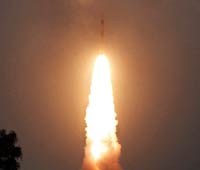India
India launches its first Moon mission
Article published on the 2008-10-22 Latest update 2008-10-22 11:10 TU
Chandrayaan-1 will reach the Moon’s orbit in 15 days, and spend two years there mapping the Moon’s surface. Landing a probe on the Moon’s surface is also a part of the 80 million dollar (62 million euro) mission.
The European Space Agency (ESA), which contributed scientific equipment to the orbiter, also lauded the launch. “In an era of renewed interest for the Moon on a worldwide scale, the … Chandrayaan-1 is a new opportunity for Europe to expand its competence in lunar science while tightening the long-standing relationship with India – an ever stronger space power,” said ESA director David Southwood.
India is hoping to use this mission as a stepping stone to a manned space programme. Work has already started on a two-person capsule, which could be launched by 2015.
It is also a technological testing ground for the lucrative commercial satellite launch market. India put an Italian and an Israeli satellite into orbit last year.
But India’s space program still has a long way to go if it wants to compete with Russia, the US, China and Europe, all of which have more advanced technology.
China, which joined Russia and the US earlier this year as the only countries to have carried out a manned spacewalk, is actively pursuing a manned mission to the Moon.







